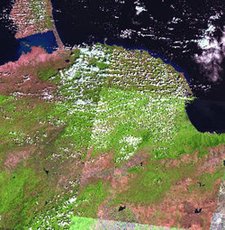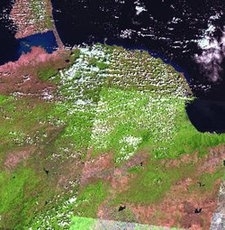Lara-Falcón dry forests
Contents
- 1 Introduction The Lara/Falcon dry forests are part of the unique tropical (Lara-Falcón dry forests) fragmented xeric areas left throughout northern Venezuela. Although of great biological importance, they have been little studied.
- 2 Location and General Description
- 3 Biodiversity Features
- 4 Current Status
- 5 Types and Severity of Threats
- 6 Justification of Ecoregion Delineation
- 7 Additional information on this ecoregion
- 8 Further Reading
Introduction The Lara/Falcon dry forests are part of the unique tropical (Lara-Falcón dry forests) fragmented xeric areas left throughout northern Venezuela. Although of great biological importance, they have been little studied.
Endemism is relatively low except for avifauna, which includes the species buffy hummingbird (Leucippus fallax) and chesnut piculet (Picumnus cinnamomeus). Damaged by agriculture and grazing only one national park, Cueva de la Quebrada del Toro National Park, protects what is left of this ecoregion.
Location and General Description
 Satellite view of the Lara-Falcon dry forests, Venezuela. (Photograph by USGS)
Satellite view of the Lara-Falcon dry forests, Venezuela. (Photograph by USGS) The Lara/Falcon dry forests lie in northern Venezuela, south of the Paraguana peninsula, east of the Gulf of Maracaibo and north of the Andes. The ecoregion is located in the states of Lara and Falcón in the northwestern side of Venezuela. This arid region lies between two xeric scrub habitats, and has as its northern and eastern limits as the Caribbean Sea. To the west it borders the Sierra de San Luis, and to the south the Sierra de Aroa. The easternmost mountains and hills of the Sierra de Falcón fall within this ecoregion; they constitute the Cueva de la Quebrada del Toro National Park. Major rivers in the region are the Hueque, Tocuro and Aroa.
The mountains, valleys and lowlands range from 100 to 1,300 meters (m) above sea level. As a result of the altitudinal variation, the ecoregion consists of various microclimates that create a mosaic of vegetation in the mountainous area. The precipitation in the area ranges from 300 to 1000 millimeters (mm). The median temperature is from 27 to 28 °C.
Ultisols and oxisols, found widely in the states of Lara and Falcón, are soils of low fertility, although the quality of the soils has not deterred agriculture in the area.
This ecoregion has a mosaic pattern of climatic formations, such as dense drought deciduous lowland woodland, submontane woodland, and evergreen seasonal lowland forest. The flora in drought deciduous lowland and submontane woodland includes Acacia farnesiana, Acanthocereus colombianus, Bombacopsis quinata, Bourreria cumanensis, Bulnesia arborea, Caesalpinia coriaria, Capparis coccolobifolia, C. flexuosa, C. linearis, C. odoratissima, C. tenuisiliqua, Cassia sp., Castela erecta, Cercidium praecox, Croton rhamnifolius, Eugenia sp., Guapira sp., Hyptis sp., Ipomoea carnea, Jatropha gossypiifolia, Lemaireocereus griseus, Libidibia coriaria, Lonchocarpus sp., Machaerium robiniaefolium, Morisonia americana, Opuntia sp., Pereskia colombiana, P. guamacho, Piptadenia flava, Pithecellobium dulce, P. unguis-cati, Platymiscium sp., Poponax tortuosa, Prosopis juliflora, Randia armata, Ritterocereus griseus, Tabebuia bilbergi, Talisia olivaeformis, and Zanthoxylum sp..
The tropical evergreen seasonal lowland forest, in the southeastern area, is more characteristic of ecoregion 27- Cordillera La Costa Montane forests.
Biodiversity Features
Plant endemism in the area is restricted to one species, Apoplanesia cryptantha, in the Fabaceae family. This endemic plant is located in deciduous woodlands in the eastern area.
There is one only endemic mammal in the area, Marmosa xerophila. This endemic opossum is found in this ecoregion and others in dry forests in northern Colombia and Venezuela. Marmosa is very well adapted to dry habitats, and is mainly found in deciduous forest.
The high endemic number of birds in this and other ecoregions is restricted to arid lowlands. The yellow-shouldered amazon (Amazona barbadensis) has a "vulnerable status", and the Maracaibo tody-flycatcher (Todirotrum viridanum) has a "near threatened" status. The rest of the endemic birds are under the status "least concern"; they include the pygmy swift (Tachornis furcata), buffy hummingbird (Leucippus fallax), chesnut piculet (Picumnus cinnamomeus), white-whiskered spinetail (Synallaxis candei), black-backed antshrike (Sakesphorus melanonotus), slender-billd tyrannulet (Inezia tenuirostris), tocuyo sparrow (Arremonops tocuyensis), and vermilion cardinal (Cardinalis phoeniceus).
Current Status
The entire region has been severely affected by agriculture and livestock grazing. The most altered areas are in the north and central parts of the ecoregion.
The only protected habitat block is Cueva de la Quebrada del Toro National Park. The Park has an extension of 8,500 hectares (ha). (UNEP), and contains one of the most spectacular caverns of Venezuela.
Types and Severity of Threats
- Destruction of habitat by agriculture and grazing.
- Domestic pet trade threatens the yellow-shouldered amazon, despite the fact that the law in Venezuela protects it.
- Natural disasters, such as drought, can affect the populations of the endemic birds in the ecoregion.
Justification of Ecoregion Delineation
These are one of several dry forest [[region]s] of in the vicinity of the Maracaibo Basin and Cordillera de Mérida. This ecoregion encompasses the Venezuelan states of Lara and Falcón, and preliminary delineation’s follow Huber and Alarcón. Linework was subsequently reviewed and modified by Robert Smith, who identified the region as unique based on species endemism and historic coverage’s.
Additional information on this ecoregion
- For a shorter summary of this entry, see the WWF WildWorld profile of this ecoregion.
- To see the species that live in this ecoregion, including images and threat levels, see the WWF Wildfinder description of this ecoregion.
- World Wildlife Fund Homepage
Further Reading
- Eisenberg, J. F. 1989. Mammals of the Neotropics: The Northern Neotropics Volume 1. The University of Chicago Press, Chicago. ISBN: 0226195392.
- Gabaldon, M. 1992. Parques Nacionales de Venezuela. Instituto Nacional de Parques, Caracas, Venezuela.
- Huber, O., and D. Frame. 1988. Venezuela.D. Campbell and H.D. Hammond (eds)., editors. Floristic Inventory of Tropical Countries. The New York Botanical Garden., Bronk. ISBN: 0893273333.
- Huber, O., and C. Alarcon. 1988. Mapa de Vegetacion de Venezuela. Republica de Venezuela, Ministerio del Ambiente y de los Recursos Naturales Renovables, Caracas, Venezuela.
- Stattersfield, A.J., M.J. Crosby, A.J. Long, and D.C. Wege, editors. 1998. Endemic bird areas of the World: Priorities for biodiversity conservation. BirdLife International, Cambridge, UK.
- Smith, R. Personal communications. June 16, 1994. Concerning delineation’s of northern Venezuelan ecoregions.
- UNESCO. 1981. Vegetation Map of South America: Explanatory notes. UNESCO, Paris.
- Venezuela, G.O. 2000. Primer Informe de Venezuela sobre Diversidad Biologica. Ministerio del Ambiente y de los Recursos Naturales, Oficina Nacional de Diversidad Biológica., Caracas, Venezuela.
| Disclaimer: This article is taken wholly from, or contains information that was originally published by, the World Wildlife Fund. Topic editors and authors for the Encyclopedia of Earth may have edited its content or added new information. The use of information from the World Wildlife Fund should not be construed as support for or endorsement by that organization for any new information added by EoE personnel, or for any editing of the original content. |
